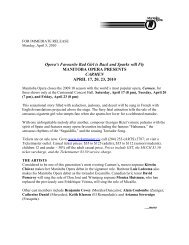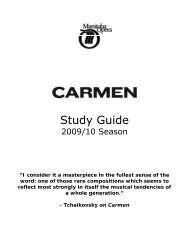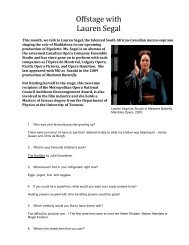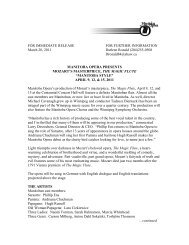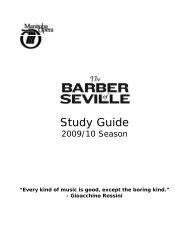La Traviata Study Guide - Manitoba Opera
La Traviata Study Guide - Manitoba Opera
La Traviata Study Guide - Manitoba Opera
Create successful ePaper yourself
Turn your PDF publications into a flip-book with our unique Google optimized e-Paper software.
A SHORT INTRODUCTION TO OPERA<br />
An opera, like a play, is a dramatic form of theatre that includes scenery, props, and costumes.<br />
In opera, however, the actors are trained singers who sing their lines instead of speaking them.<br />
An orchestra accompanies the singers. A conductor coordinates both the singers on stage and the<br />
musicians in the orchestra pit.<br />
<strong>Opera</strong> consists of many dimensions: the human voice, orchestral music, the visual arts (scenery,<br />
costumes and special effects), drama (tragedy or comedy), and occasionally dance. The melding<br />
of these elements can make you cry tears of joy or sadness, produce laughter or anger, but most<br />
importantly transport you to a magical land of music and song.<br />
<strong>Opera</strong> has its roots in Greek drama and originated in Florence, Italy, in the late 1500’s, with a<br />
small group of men who were members of a Camerata (Italian for society). The intellectuals,<br />
poets and musicians of the Camerata decided they wanted words to be a featured aspect of<br />
music. They used ancient Greek drama as their inspiration, including the use of a chorus to<br />
comment on the action. The Camerata laid down three principles for their new art form:<br />
♦ The text must be understood; the accompaniment must be very simple and should not distract<br />
from the words.<br />
♦ The words must be sung with correct and natural declamation, as if they were spoken, and<br />
must avoid the rhythms of songs.<br />
♦ The melody must interpret the feeling of the text.<br />
The first significant composer to fully develop the ideas of the Camerata was Jacopo Peri (1561-<br />
1633), whose opera Dafne, based on a Greek myth, was performed in 1594 and is regarded as the<br />
first opera. <strong>Opera</strong>s continue to be composed today.<br />
<strong>Opera</strong>s are divided into scenes and acts that contain different types of vocal pieces for one or<br />
many singers. An aria is a vocal solo that focuses on a character’s emotions rather than actions.<br />
A recitative is sung dialogue or speech that occurs between arias and ensembles.<br />
Composers write the score or the music for the opera. Sometimes the composer will also write<br />
the text of the opera, but most often they work with a librettist. The story of the opera is written<br />
as a libretto, a text that is easily set to music. In the past, the libretto was also bound and sold to<br />
the audience. Today, the audience can easily follow the plot with the use of surtitles. Surtitles<br />
are the English translation of the libretto, which are projected onto a screen above the stage.<br />
There are several differences between opera and musicals like Phantom of the <strong>Opera</strong>. One<br />
significant difference is the ‘partnership’ found between the music and the drama in an opera.<br />
While musicals use songs to help tell a story, in an opera, the music contributes to the drama, it<br />
does not only accompany it. The musical style in is another important difference between the two<br />
art forms; opera is usually classical and complex, while musicals feature pop songs and<br />
sometimes rock and roll. Also, singers in musicals have microphones hidden in their costumes<br />
or wigs to amplify their voices. The voices of opera singers are so strong, no amplification is<br />
needed, even in a large venue. Furthermore, operas are almost completely sung, while the use of<br />
spoken words are more common to musicals. There are some operas with spoken words and<br />
these are called singspiels (German) and opera-comique (French). Examples are Mozart’s The<br />
Magic Flute and Bizet’s Carmen, respectively.<br />
5



